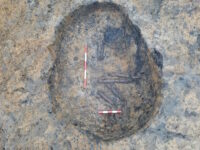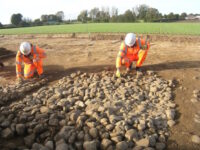 An archaeological dig at the site of a sewer for a new prison currently being built in Full Sutton, East Yorkshire, has unearthed a 4,500-year-old grave and funerary monument. The individual was buried in the crouched position (knees bent and drawn up towards the chest) in a pit grave surrounded by a ring ditch and topped with a mound of stones. This type of mound is known as a round barrow, a common burial monument in Late Neolithic Britain.
An archaeological dig at the site of a sewer for a new prison currently being built in Full Sutton, East Yorkshire, has unearthed a 4,500-year-old grave and funerary monument. The individual was buried in the crouched position (knees bent and drawn up towards the chest) in a pit grave surrounded by a ring ditch and topped with a mound of stones. This type of mound is known as a round barrow, a common burial monument in Late Neolithic Britain.
Interestingly, the round barrow was constructed very close to, but not over, what archaeologists call a ‘burnt mound’. These enigmatic prehistoric sites are relatively common in upland areas where they survive as mounds of burnt stone and charcoal, but the lowland examples are less obvious due to being flattened by later ploughing. Little is known about what burnt mounds were used for, and their excavation is seen as an important research priority. […]
Previous excavations of similar sites in the UK and Ireland have shown that water was an important part of the process with water troughs lined with wood or clay being discovered. Other sites include earth-ovens or roasting pits and the combined evidence has led to several theories about what activities were carried out. The main theory is that stones were heated up and placed in the troughs to heat water, either during the process of dyeing cloth or cooking. Alternatively, some burnt mound sites include structures that could have been used as saunas.
 The round barrow was disturbed by later agricultural activity, but the burial fortunately was not damaged. The skeletal remains were found in unusually good condition. The acidic soil of the area is harsh on bones, but in this case the grave had been backfilled with burned stone and charcoal from the adjacent burnt mound, helping to preserve the skeleton.
The round barrow was disturbed by later agricultural activity, but the burial fortunately was not damaged. The skeletal remains were found in unusually good condition. The acidic soil of the area is harsh on bones, but in this case the grave had been backfilled with burned stone and charcoal from the adjacent burnt mound, helping to preserve the skeleton.
A small earth oven and a deep pit believed to have been a well were also found near the barrow. Heating stones were left in the oven from its last use and soil samples will be analyzed for traces of what might have been cooked there. The bottom of the well was still waterlogged, preserving part of its prehistoric wooden lining, a particularly exciting find. The waterlogged fill at the bottom of the well will also be sampled and analyzed for plant, animal and insect remains.